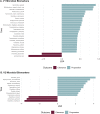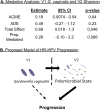Cervicovaginal microbiome and natural history of HPV in a longitudinal study
- PMID: 32214382
- PMCID: PMC7098574
- DOI: 10.1371/journal.ppat.1008376
Cervicovaginal microbiome and natural history of HPV in a longitudinal study
Abstract
Background: Human papillomavirus (HPV) infection is one of the most common sexually transmitted infections. However, only a small percentage of high-risk (HR) HPV infections progress to cervical precancer and cancer. In this study, we investigated the role of the cervicovaginal microbiome (CVM) in the natural history of HR-HPV.
Methods: This study was nested within the placebo arm of the Costa Rica HPV Vaccine Trial that included women aged 18-25 years of age. Cervical samples from two visits of women with an incident HR-HPV infection (n = 273 women) were used to evaluate the prospective role of the CVM on the natural history of HR-HPV. We focus specifically on infection clearance, persistence, and progression to cervical intraepithelial neoplasia grade 2 and 3 (CIN2+). The CVM was characterized by amplification and sequencing the bacterial 16S V4 rRNA gene region and the fungal ITS1 region using an Illumina MiSeq platform. OTU clustering was performed using QIIME2. Functional groups were imputed using PICRUSt and statistical analyses were performed using R.
Results: At Visit 1 (V1) abundance of Lactobacillus iners was associated with clearance of incident HR-HPV infections (Linear Discriminant Analysis (LDA)>4.0), whereas V1 Gardnerella was the dominant biomarker for HR-HPV progression (LDA>4.0). At visit 2 (V2), increased microbial Shannon diversity was significantly associated with progression to CIN2+ (p = 0.027). Multivariate mediation analysis revealed that the positive association of V1 Gardnerella with CIN2+ progression was due to the increased cervicovaginal diversity at V2 (p = 0.040). A full multivariate model of key components of the CVM showed significant protective effects via V1 genus Lactobacillus, OR = 0.41 (0.22-0.79), V1 fungal diversity, OR = 0.90 (0.82-1.00) and V1 functional Cell Motility pathway, OR = 0.75 (0.62-0.92), whereas V2 bacterial diversity, OR = 1.19 (1.03-1.38) was shown to be predictive of progression to CIN2+.
Conclusion: This study demonstrates that features of the cervicovaginal microbiome are associated with HR-HPV progression in a prospective longitudinal cohort. The analyses indicated that the association of Gardnerella and progression to CIN2+ may actually be mediated by subsequent elevation of microbial diversity. Identified features of the microbiome associated with HR-HPV progression may be targets for therapeutic manipulation to prevent CIN2+.
Trial registration: ClinicalTrials.gov NCT00128661.
Conflict of interest statement
I have read the journal's policy and have the following conflicts: John T. Schiller and Douglas R. Lowy report that they are named inventors on US Government-owned HPV vaccine patents that are licensed to GlaxoSmithKline and Merck and for which the National Cancer Institute receives licensing fees. They are entitled to limited royalties as specified by federal law.
Figures






References
-
- Ho G. Y., Burk R. D., Klein S., Kadish A. S., Chang C. J., Palan P., … & Romney S. (1995). Persistent genital human papillomavirus infection as a risk factor for persistent cervical dysplasia. JNCI: Journal of the National Cancer Institute, 87(18), 1365–1371. - PubMed
Publication types
MeSH terms
Associated data
Grants and funding
LinkOut - more resources
Full Text Sources
Other Literature Sources
Medical
Research Materials

